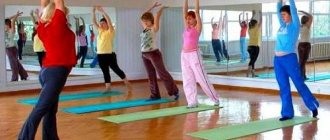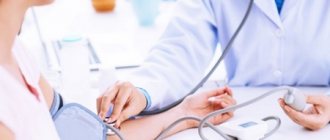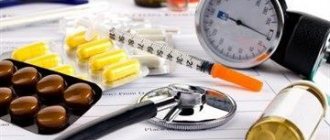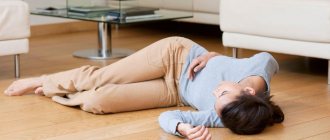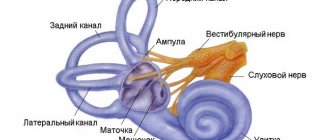Basic principles of breathing exercises
With vegetative-vascular dystonia, patients often experience attacks of lack of oxygen, suffocation, and shortness of breath. Against the background of hypoxia, there is an increase in heart rate, increased blood pressure, dizziness and even fainting. This is due to an increased feeling of anxiety, so to eliminate oxygen starvation, the nervous system is first calmed.
To treat attacks, you should not immediately resort to the use of antidepressants and other potent drugs. The patient needs to improve his breathing; for this purpose, you can choose a set of special exercises.
Proper breathing saturates the body with sufficient oxygen and ensures the normal functioning of the brain and heart muscle. When air enters, blood circulation in the tissues improves.
How to breathe correctly:
- completely fill the chest with oxygen;
- use not only your lungs, but also your stomach and diaphragm to breathe;
- set a breathing rhythm synchronous with the pace of physical activity;
- breathe through your nose, exhaling through your mouth.
How to get rid of painful sensations
Deep breathing is a natural biological process for most people. As soon as Buteyko breathing exercises begin, this process is suppressed and forcibly stopped, which leads to the appearance of persistent pain in the chest. The developer of the method himself claims that you just need to continue practicing and perform shallow breathing correctly.
Over time, the body gets used to the new conditions, begins to withstand the load - the pain will simply disappear.
Breathing exercises
Below is a standard set of exercises aimed at improving breathing and enriching organs and systems with oxygen. The number of repetitions for each is from eight to twelve times.
Exercises:
- Inhale and exhale rhythmically three to five times through your nose without opening your mouth. Closing your left nostril, breathe through your right, and vice versa.
- Use your abdominal muscles to breathe. While inhaling, round your stomach as much as possible and breathe through your nose. As you exhale, draw in your stomach.
- Hold your stomach, inhale deeply through your chest, and exhale forcefully through your nose.
- Inhale deeply, expanding your lungs and rounding your belly. Exhale smoothly - first draw in the abdominal wall, and then the chest. Keep one hand on your chest, the other on your stomach.
- Inhale the air so that the lungs expand and the stomach retracts. As you exhale, draw in your chest and round your stomach. Breathe through your nose.
- Gently slow down the rhythm of your breathing, and then evenly speed it up to normal.
- Connect breathing with physical activity. Start breathing properly while walking at a slow pace. Focus on synchronizing your breathing and walking. Complete the task for two to three minutes.
- Place your feet together, lower your arms. Raise your arms up through your sides as you inhale, and lower them as you exhale.
- Breathe voluntarily, simultaneously rotating your arms at your shoulders. Move forward and backward.
- Inhale slowly through your nose, exhale quickly through your mouth, then hold your breath for 2-3 seconds.
Before performing any set of exercises, be sure to consult your doctor. If it is difficult for you to perform the complex, do not force it. The reason may lie in pulmonary failure and other serious diseases, the treatment of which is possible only under the supervision of a doctor.
Similar chapters from other books:
Dyspnea
Shortness of breath One of the most common symptoms of diseases of the respiratory system is shortness of breath, characterized by changes in the frequency, depth and rhythm of breathing. Shortness of breath can be accompanied by both a sharp increase in breathing (tachypyoe), and a decrease in breathing (bradypyoe), up to
DYSPNEA
DYSPNEA Sambucus 2X, 3X - night attacks of sharp expiratory shortness of breath with cough. Ipecac 3, 6 - sharp expiratory shortness of breath, suffocation with characteristic wheezing and profuse wheezing on auscultation. The attack ends with the release of a large amount
Dyspnea
Shortness of breath Shortness of breath is a violation of the frequency, rhythm and depth of breathing, as if the patient does not have enough air. Physiological shortness of breath usually occurs after intense physical exertion, when rising to a height where the oxygen content in the air is significantly lower than usual, when
Dyspnea
Shortness of breath Shortness of breath may be associated with pathologies of the cardiovascular and respiratory systems. Chest pain and shortness of breath may be a symptom of acute myocardial infarction. When the coronary arteries are damaged, pain and shortness of breath arise and intensify mainly during physical activity.
Dyspnea
Shortness of breath Shortness of breath refers to rapid breathing, which can also be observed at rest. The severity of shortness of breath may vary. In some cases, a child with shortness of breath plays calmly, has a good appetite, and feels normal. But at the slightest physical
DYSPNEA
Shortness of breath This concept characterizes the subjective experience of breathing discomfort of varying degrees of intensity. It occurs quite often in cardiac patients. As a rule, shortness of breath is manifested by a feeling of lack of air or difficulty breathing. For shortness of breath
Dyspnea
Shortness of breath Shortness of breath is a symptom of many diseases. And this is one of the first signs of fatigue. With shortness of breath, the rhythm, frequency and depth of breathing are disrupted, which manifests itself in a feeling of lack of air. Shortness of breath can develop with emphysema, bronchial asthma and
Dyspnea
Shortness of breath Shortness of breath, aggravated by movement - Arsenicum. Prostration, insomnia arising from physical exertion - Arsenicum. Shortness of breath in a sitting position; shortness of breath after sleep; shortness of breath indoors; when dancing or walking quickly - Sepia. Severe shortness of breath, wheezing,
BREATHNESS DURING SLEEP
SLEEP BREATHNESS The most serious and most common of all sleep disorders is called sleep apnea (shortness of breath). This is the medical term for stopping breathing during sleep. Research suggests that 25% of all Americans aged
Dyspnea
30. Shortness of breath Shortness of breath is a feeling of lack of air during physical activity or at rest, accompanied by an increase in the number of respiratory movements per minute. There are inspiratory shortness of breath (when it is difficult to inhale), expiratory shortness of breath (if it is difficult to exhale) and mixed
Dyspnea
Shortness of breath Take aloe juice – 3 tbsp. l., radish juice - 1/2 cup, honey - 2-3 tbsp. l., oats – 50 g, water – 1/2 l. Mix fresh aloe and radish juices well. Sort the oats, rinse thoroughly, cover with cold water and put on fire. Bring to a boil, then turn off the gas and let
Gymnastics according to Strelnikova
The technique developed by A.N. helps to achieve a high healing effect for vegetative-vascular dystonia. Strelnikova. The exercises are combined with physical movements, performed regularly and exactly as described in the instructions.
It is advisable to perform breathing exercises only after consultation with your doctor.
Exercises - repeat each eight to twelve times:
- Stretch your arms up, first bending them at the elbows. Place them above your shoulders, with the inner side facing away from you. On a short inhalation, clasp your palms. Exhale slowly and unclench your hands.
- Stand up and straighten your back, clench your fists, lowering your hands to your sides. Inhale briefly and make a sharp movement with your hands, pushing them down, unclench your palms. Tighten your shoulders and open your fingers, holding them in this position. As you exhale, return to the original position.
- Stand up straight, spread your feet shoulder-width apart, and lower your arms down. Lean forward slightly, lower your head and shoulders, relax your muscles. At the end of the tilt, inhale, returning to the original position - exhale.
- In the starting position, standing, bend your arms at the elbow joint and raise them to your shoulders. Turn your palms inward so that they look at each other, relax your fingers. Give yourself a hug. Inhale when your hands are at chest level. As you exhale, spread your arms to the sides.
- Stand up, put your hands down, spread your legs wide. While inhaling quickly, squat down, turning your body to the right side and raising your arms to your waist. As you exhale, return to the original position and perform “shaking” movements with your hands.
- Bend down slightly as you inhale. Straighten up and bend your lower back a little, hug yourself by your shoulders, then exhale smoothly and evenly.
- Look to the side as you inhale, as you exhale return your head to the starting position, and as you inhale look in the opposite direction, using your neck muscles.
- Stand up and straighten your back. Tilt your head towards your right shoulder while inhaling. Then repeat the exercise by tilting your head towards the opposite shoulder. Exhale between head tilts.
- Take a classic starting position, with your feet shoulder-width apart. As you inhale, lower your head, gently tilt it back and look up, inhale again. Exhale between breaths.
- Step your right leg forward. Distribute your weight evenly on both legs. Then shift your weight to your right leg. Do shallow squats and inhale. Straighten your knee and shift your weight to your left leg. Squat down on your left leg and inhale again. Exhale between squats.
- Raise one leg and bend it at the knee, squat down, leaning on the other leg, and at the same time take a small breath. Lower the raised leg, straighten the other at the knee, and exhale briefly. Repeat the exercise, changing the position of your legs.
Be careful when performing the complex; some exercises do not benefit everyone. For example, hypertensive patients, as well as people who do not suffer from arterial hypertension, should avoid tilting and turning their heads during occasional periods of increased blood pressure.
You will learn more about Strelnikova’s method in the following video:
Gymnastics according to Buteyko
Method K.P. Buteyko is called volitional elimination of deep breathing or VLDG. The main goal of the complex is to reduce breathing through muscle relaxation, make it smooth and slow, without deep and frequent breaths.
Basic principles:
- studying your breathing;
- decreased breathing due to muscle relaxation;
- preventing seizures;
- getting rid of drug addiction, which often occurs with VSD;
- management of factors affecting breathing.
Take the starting position to perform exercises according to the Buteyko method - sit and straighten your back, bend your knees, lean against the legs of the chair, relax your stomach. Don't get nervous or mentally question whether I'm doing the task correctly. Don't worry about breathing, the technique will not cause harm.
Before performing the main complex, take a “control pause”. To do this, breathe calmly, exhale slowly, hold your breath for 15-20 seconds. After the delay, inhale and exhale smoothly and measuredly. When performing this task, do not hold your breath unless you can, otherwise it may cause shortness of breath. Do not pause for more than 20 seconds.
Why do “zero” exercises? The control pause allows you to determine the level of carbon dioxide in the body. The more carbon dioxide, the longer and lighter the sample.
The main exercise consists of a weak and silent inhalation, in which the patient does not use the chest and abdominal muscles, but keeps them in a relaxed state. The patient inhales for 2 seconds and exhales for four seconds. Try this practice, five minutes is enough. After the exercise, measure the control pause again.
The total lesson time is a quarter of an hour. After just a few minutes of doing this, the nose begins to breathe, and the nervous system returns to normal.
Recommendations
If you suspect vegetative-vascular dystonia, consult a doctor immediately. Do not begin self-treatment of the disease, including with the help of breathing exercises, without a prescription, especially if you have not been diagnosed. Remember that VSD has manifestations characteristic of many other diseases.
If you have been diagnosed with vegetative-vascular dystonia, consult your doctor about the advisability of performing gymnastics.
For maximum effect, use not only breathing exercises, but also perform moderate physical activity, eat healthy food, get enough sleep, and separate work and rest schedules.
What can and cannot be done with VSD?
A patient diagnosed with VSD is best suited for swimming, cycling, race walking, and aerobics. Under no circumstances should you engage in wrestling, weightlifting or team sports in which the patient will feel responsible for the overall result. A massage course will be an excellent addition to physical exercise, but it must be performed by a professional. And don’t forget about the general recommendations: maintaining a daily routine and proper nutrition. An active lifestyle and a positive outlook on life will help you get rid of the symptoms of VSD forever.

